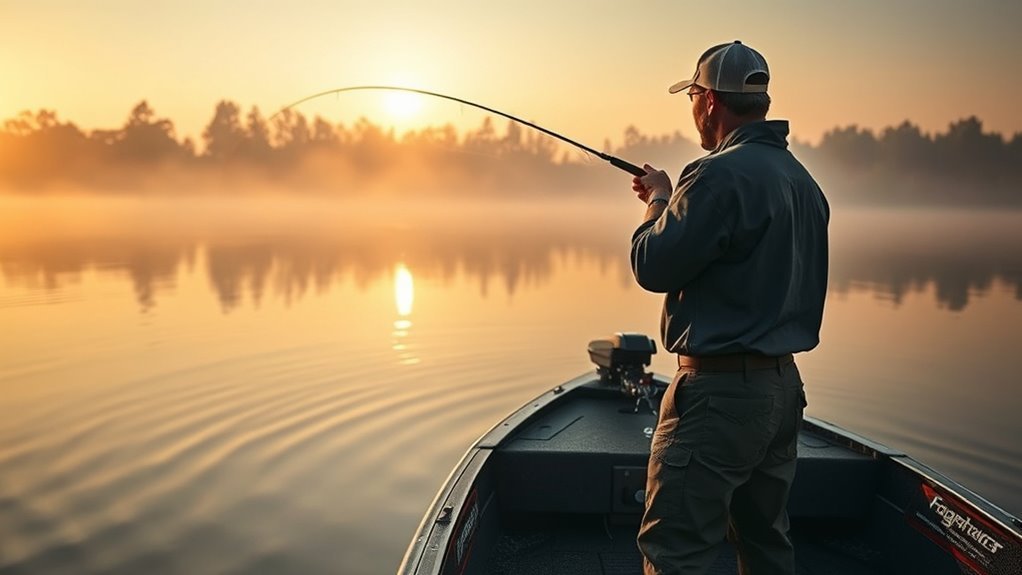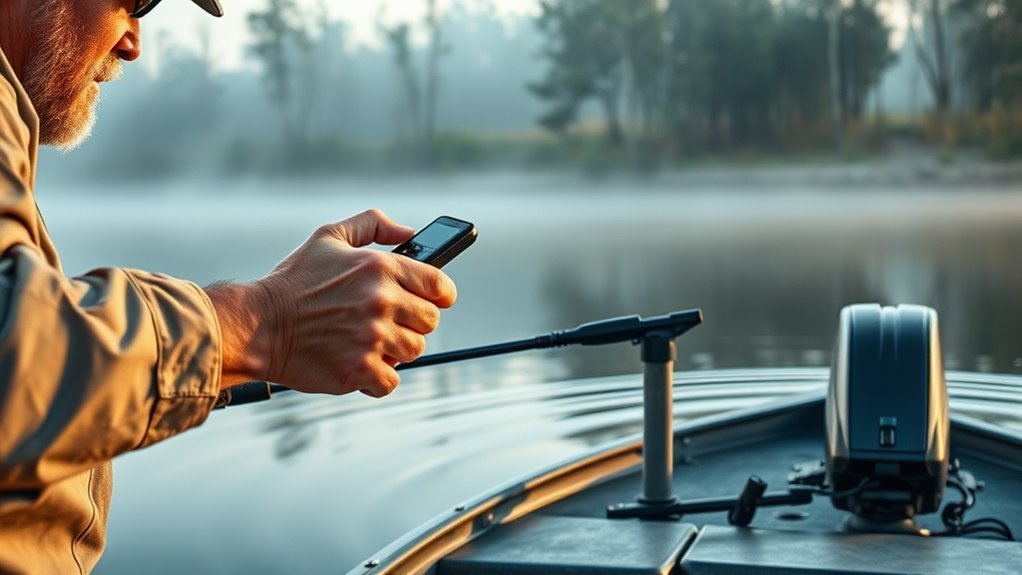We stumbled across wireless speed adjusters for fishing motors right when anglers were getting fed up with yanking starter cords and fumbling with manual controls. These RC ESC systems let you control your trolling motor with a handheld joystick—no more leaning over to adjust speed while you’re trying to land a fish. The real game-changer isn’t just the wireless convenience, though. What separates decent systems from the ones that’ll actually change how you fish comes down to five critical components.
Wireless Connectivity and Remote Control Capabilities

Why settle for yanking a starter cord when you can control your fishing motor from across the boat?
We’re talking about wireless freedom here.
The RC ESC speed controller uses six channels but only needs one to work.
Pretty efficient, right?
That handheld controller isn’t messing around.
It’s got a joystick for precise forward, reverse, and speed adjustments.
Channel 2 has a sensitivity button that cuts current to the ESC.
Safety first, we guess.
When you power on, a solid red light tells you it’s ready.
No guesswork.
The hands-free driving mode?
Pure genius.
Press a button, set your cruising speed, and let it ride.
A blue light confirms you’re in autopilot mode.
With advanced features like Spot-Lock, this wireless setup maintains your position against wind and current for better fishing efficiency.
Because apparently, we needed a light to tell us we’re being lazy.
Programmable Electronic Speed Control Settings
Fine-tuning your ESC isn’t rocket science, but it’ll make the difference between smooth sailing and frustrating jerky movements.
The Hobby Wing Programming Card connects to your ESC’s right-hand slot—negative wire facing outward.
Simple stuff.
Here’s where things get interesting.
Setting running mode to option 3 gives you forward and reverse operation.
Because sometimes you need to back out of tight spots.
Item number 6 cranked to option 4 delivers 100 percent reverse force.
Full power backwards? Yeah, we’ll take that.
The real game-changer is item 11 set to option 5.
This expands your neutral range, creating a wider center detent.
Translation: smoother speed adjustments without constant corrections.
Fifteen customizable options total.
Use the right settings, and your wireless control becomes surgical precision instead of clunky guesswork.
These customized settings can boost efficiency by enhancing speed management for extended run times on your fishing trips.
Hands-Free Cruising and Speed Management Features

Automation changes everything when you’re trying to land that perfect catch.
We’re talking about hands-free cruising mode here, and it’s working right when that blue light kicks on.
One button press, boom—your motor maintains speed automatically.
No more death grip on the controller.
The joystick handles your speed setup before you go hands-free. Forward, reverse, whatever you need.
The sensitivity button on channel 2? That’s your secret weapon. It cuts current to the ESC for precise adjustments.
Look, nobody wants to fidget with controls when fish are biting.
Single button press gets you back to manual mode instantly.
It’s that simple.
The system does the work while you focus on what matters—catching fish, not wrestling with your motor.
For even greater precision, this feature can be paired with Spot-Lock to hold your position against wind and currents.
Physical Components and Installation Requirements
Components matter, and the Hobby Wing Quick Run 880 brushed ESC isn’t messing around. This compact 1.75 x 1.25 x 1 inch unit packs serious hardware. You’ll find red and black power leads, dual yellows for positives, dual blues for negatives. Plus servo connectors, Wi-Fi receiver ports, an on/off switch, and a cooling fan.
For enhanced longevity, regular maintenance like lubrication can ensure smooth operation, similar to how high-quality materials in mounting brackets resist wear in marine environments.
| Component | Purpose | Installation Note |
|---|---|---|
| Power Leads (Red/Black) | Main power connection | Use 10-gauge wiring |
| Motor Leads (Yellow/Blue) | Motor control | Combine pairs for single motor |
| Cooling Fan | Heat management | Plugs into specific port |
| Mounting Hardware | Secure placement | VHB tape in head unit void |
Installation’s straightforward. Mount with VHB tape, wire power through spade connectors, shorten the shaft, cap unused wires. The fan keeps things cool. Simple engineering, effective results.
Performance Testing and User Operation Experience

How’s this thing actually work when you fire it up?
Testing’s pretty straightforward – flip on the ESC and grab your remote.
You’ll want to make sure the propeller spins forward and reverse properly.
That’s your basic functionality check right there.
The joystick controls your speed adjustments, while channel 2’s sensitivity button cuts power instantly.
Think emergency brake for water.
Hands-free mode kicks in with one button press, maintaining steady speed automatically.
Blue light means you’re cruising on autopilot.
Here’s what really matters during operation:
- Programming ESC item 6 to option 4 maxes reverse force at 100 percent
- Trial and error becomes your best friend without proper manuals
- Video tutorials fill the knowledge gaps manufacturers left behind
- System runs reliably once you figure it out
Learning curve’s real though.
To keep everything running smoothly, regularly inspect your wiring for damage to prevent voltage drops.
Frequently Asked Questions
How Does a Motor Speed Controller Work?
We’ll explain speed regulation simply: motor speed controllers adjust power flow to motors by receiving wireless signals from remote controls, modulating current through positive and negative leads to achieve precise forward, reverse, and stopping functions.
What Size PWM for Trolling Motor?
While massive motors demand robust controllers, we’ll find trolling motors need precise Size Selection for PWM signals—typically 1000-2000 microsecond pulse widths work perfectly, though you’ll want matching ESC specifications for best performance.